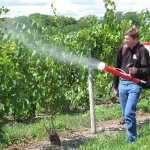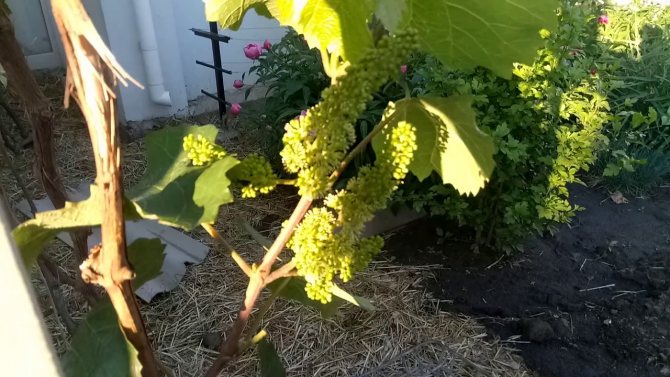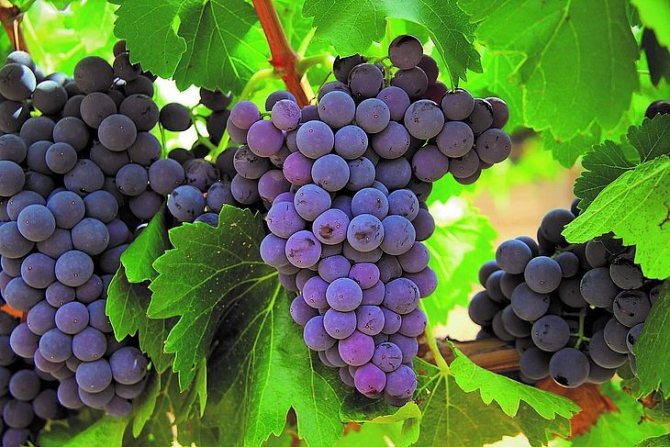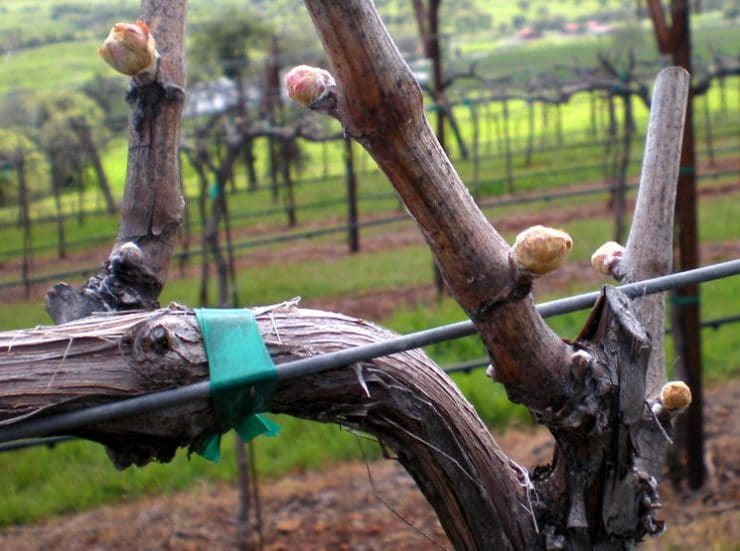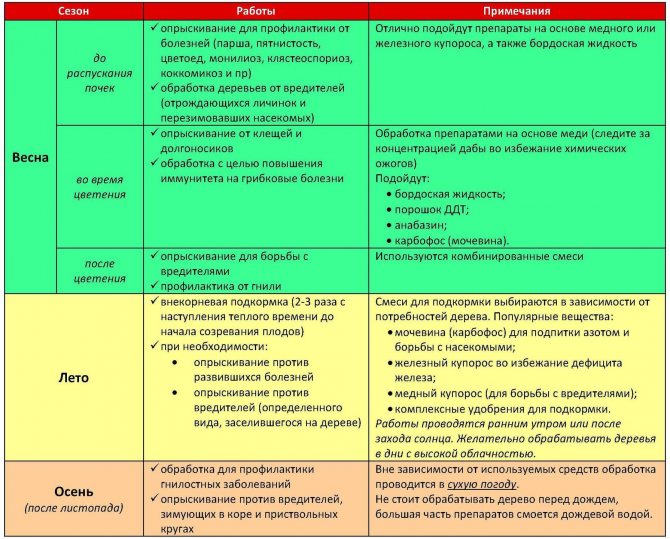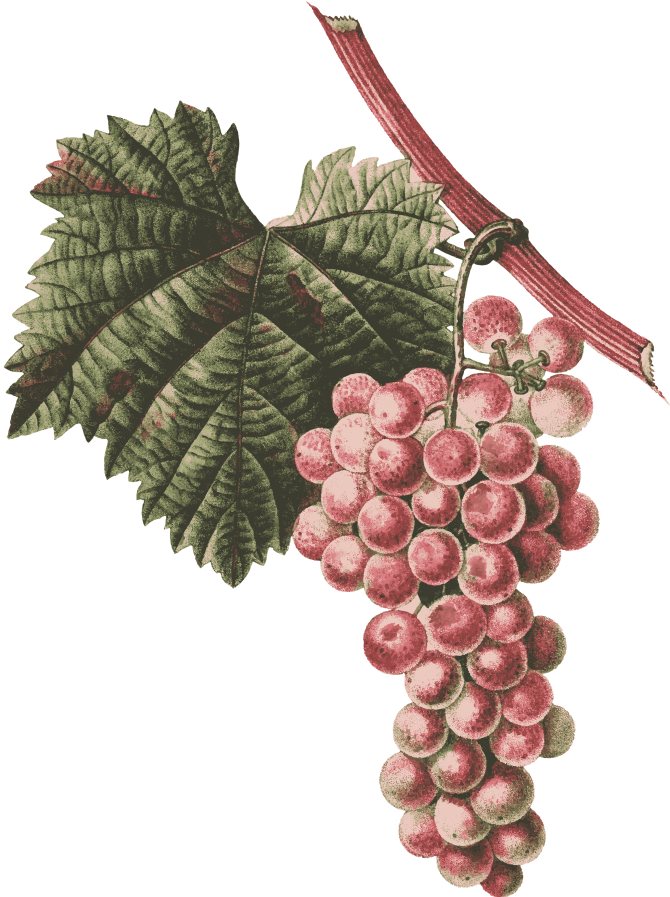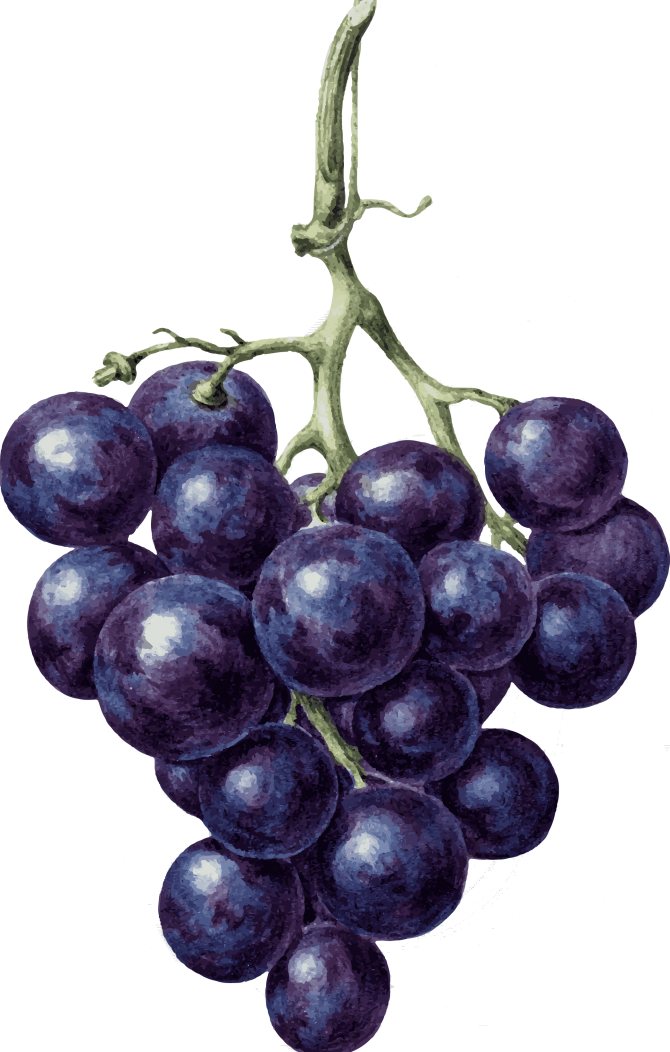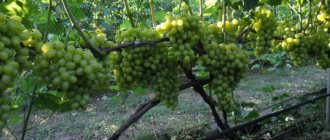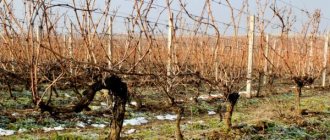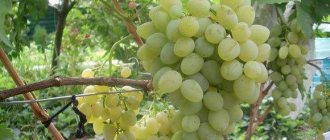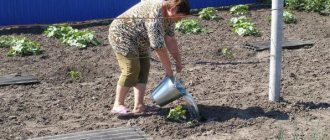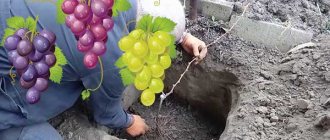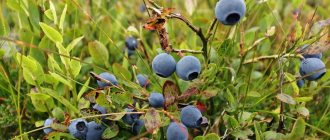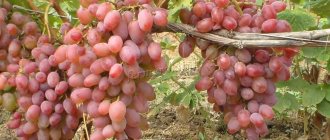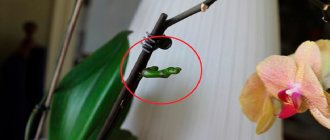In order for the grapes to please with their appearance (to be healthy) and, most importantly, to bear fruit abundantly, it is important not only to form it correctly (cut it in autumn and spring), tie it up and feed it, but also to carry out preventive spring treatment of the vine against fungal diseases and insect pests in a timely manner.
Below you will find all the relevant and useful information about spraying grapes in the spring against diseases and pests!
Terms of spring processing of grapes
If it is planned to carry out the processing of grapes, then it is worth considering that, for example, before the buds have opened, pests cannot harm the bush, but after pecking a leaf, the disease can immediately affect the plant.
It is also necessary to pay attention to the fact that some drugs are not allowed to get on the leaves of the plant, otherwise they can cause a burn.
Thus, the spring treatments of the vine can be divided into three main stages, depending on the stage of bud opening:
- The first stage of treatment is the earliest when the buds are just swelling.
- The second stage of processing is carried out when the bud intensively, throughout the vine, begins to bloom. At this moment, the diseases of the bush are activated and harmful insects begin to appear.
- The third stage is carried out only when the leaf is completely formed on the bush.
Here are the main reasons why it is almost impossible to do without grape processing:
- Fungal spores are in the air. There are especially many of them where there are clusters of garden plantings.
- An unkempt garden and directly a place under a bush, where last year's foliage and cut branches are not removed - a place where they “winter” and spores feel great.
- Disputes are also in the ground. Therefore, after the spring digging, the gardener himself releases them into the air.
It will not be possible to get rid of the disputes completely. But it is possible to reduce their concentration - and this is the most important task of spring processing of the bush. Today, specialized stores provide gardeners with a wide selection of chemical and natural preparations that can provide effective assistance in the fight against diseases.
Along with the departure of the last frosts and the removal of insulating shelters, preparations should be made for processing the vine. It is necessary to start with an eradicating spraying. This is a type of spraying that takes place not only on the surface of the vine, but also on the surface of the soil adjacent to the bush.
As soon as a leaf has appeared - this spraying is called prophylactic - it is already done on the foliage of the plant, when the phase of appearance of 4-5 leaves begins.
An experienced gardener in the video below talks about what lesions and diseases of grapes exist, and also shares methods of dealing with them in the spring:
Why cultivate a vineyard in spring
The main purpose of the spring treatments of grape plantations is to prevent diseases, reduce the likelihood of insect damage to the crop. It is easier to prevent the problem than to spend time and energy later on treating bushes, getting rid of ticks or aphids.
Spring activities do not rule out summer treatments, but they help to significantly reduce the risk of disease. It is difficult to predict what the weather will be like in the summer.Prolonged rains, drought, coolness - all these factors affect the state of the vineyard, the yield. Treated plantings are unattractive to pests, the grapes are less sick, and the yield increases.
Methods:
- spraying;
- soil treatment around the bushes.
The sleeves of bushes, trunks, vines, trunks are processed.
They use chemical compounds, biological products, folk remedies. For prevention, effective and environmentally friendly formulations of natural ingredients are suitable. But when infections appear, they often do not give a result, you have to use "chemistry".
Attention!
Not only the plantings themselves are sprayed, but the stab zones, the aisles of the grapes.
Soil cultivation includes loosening the top layer (up to 13-15 cm) in the near-trunk circle, mulching with compost, peat.
How to spray?
There is a large mass of preparations and folk remedies for processing vines. Such processing can be carried out using:
- Fungicides - systemic and contact, they can cope with most diseases of grapes.
- An aqueous solution of baking soda.
- Copper sulfate, which is an excellent source of trace elements, also acts as a fungicide, fighting the germination of moss or lichen in an excessively humid environment.
- Colloidal sulfur - it can be used in combination with copper fungicides. Colloidal sulfur creates a powerful barrier, preventing various diseases of the vine for a period of 10-15 days.
- Specialized drugs like Falcon and Lifeguard.
- Biological preparations.
- Folk remedies in which infusions from different herbs are used, a variety of improvised substances.
Bordeaux liquid
Bordeaux liquid can be used to treat plantings against fungal infections. Such a remedy worked well when the kidney began to grow and the tip turned green. For processing, you need to take a 3% solution of Bordeaux liquid. This solution is considered the most popular fungicide. The composition includes milk of lime with copper sulfate. To prepare the mixture, you need 10 liters of solution, 300 grams of copper sulfate and 300 grams of quicklime. You should not mix Bordeaux liquid with other drugs.
This has already been tested many times by experienced gardeners and winegrowers. The finished solution turns out to be quite thick and dense. Spring treatment with effective copper sulfate should be done annually. With such a mixture, you can cure plantings from a fungal infection, get rid of common diseases and pests, such as a tick. You can see in more detail how to properly mix milk of lime with copper sulfate and how to process grapes in early spring in a photo or video.
Biological agents
If you do not want to use chemicals on your site, then you can choose biological preparations. They are also able to effectively fight plant diseases and exterminate harmful insects.
It should be borne in mind that fungicides not only rid the plant of pests, but are also capable of destroying microflora that is not pathogenic. That is, treatment with biological products will allow you to preserve the necessary bacteria and insects on the vine and contribute to the proper development.
The main, most common biological agents include:
- Fitosporin-M;
- Trichodermin;
- Planriz;
- Pentofag;
- Gaupsin.
Fitosporin-M
This biological product has the following advantages when used:
- Eliminates diseases caused by fungi, bacteria, late blight, bacterial cancer, powdery mildew.
- Can be used both on planting material and on adult plants.
- It can be used completely at any stage of the growing season.
- It is environmentally friendly and safe for both humans and pollinating insects.
- The price category is affordable.
Disadvantages:
- There is no such effectiveness as a group of drugs belonging to fungicides.
- In the sun, the components of the drug decompose quickly.
In order for the effectiveness of Fitosporin to be maximized, it is necessary to process the vine three times. The first time at the stage of swelling of the buds, the second treatment - at the stage of inflorescences, the third treatment - after giving birth.
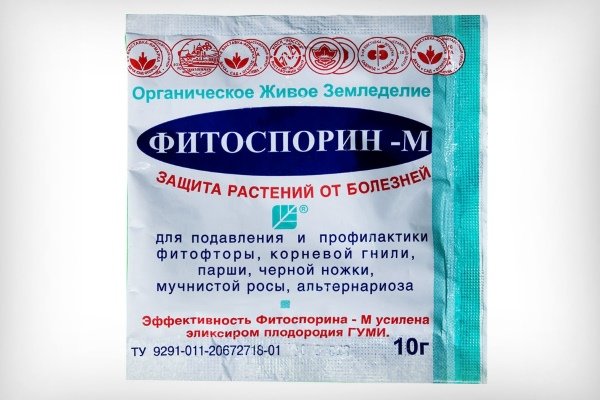
Aktofit
This drug belongs to the group of biological insecticides. Effective against ticks, aphids and other pests.
The main active ingredient of the drug is the neurotoxin avertexin, which destroys the nervous system of pests.
Before you start using the drug, you should make sure that the ambient temperature does not drop below +18 ° C. Atofit should be thoroughly mixed with water until a homogeneous emulsion is obtained.
On grapes, Aktofit effectively eliminates such pests as bunchy and spider mites. The required number of treatments to fix the problem is 1-2 times.
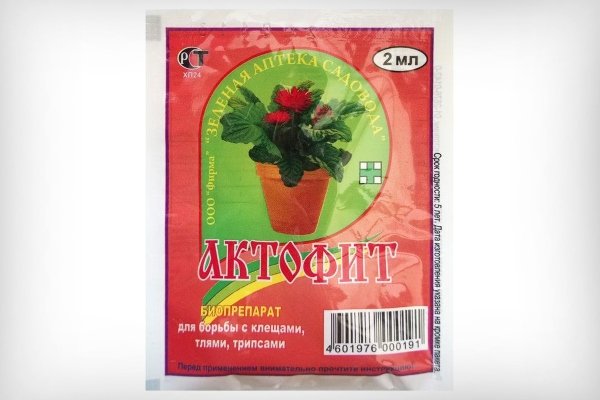

Trichodermin
The drug is similar in action to a group of fungicides. It has a pronounced antibiotic effect. The drug has proven itself in the fight against most bacterial infections and fungal diseases.
Grapes treated with Trichodermin can get rid of cocomycosis, scab, powdery mildew, and rust.
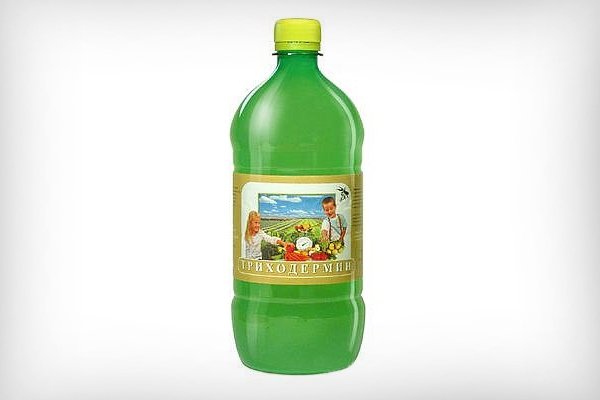

Important: take only dechlorinated water to dilute the drug, otherwise the spores of Trichoderma fungi (they are the basis of the drug) will be killed.
Ecogel
Eco-gel activates the internal forces of the vine, so that the plant itself effectively copes with diseases and pests. The drug exhibits the following properties: immunomodulatory, antimicrobial, antifungal, fungistatic.
Treatment in unfavorable weather conditions softens the impact on the plant, activates its internal forces to fight. The first treatment can be carried out by watering the plant at the root - this is done before the first leaves appear on the vine. After the leaf is formed, spraying can be carried out.
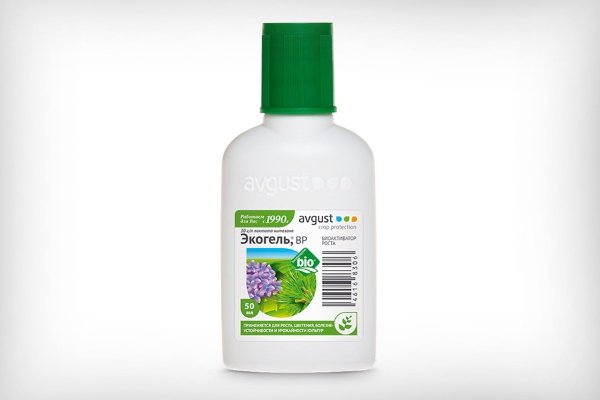

Mikosan
The toxic substances that make up the preparation Mikosan do not penetrate into the plant, therefore they do not harm it, and, accordingly, a person. Also, like most biological products, Mikosan stimulates the plant's own immunity. This ensures the effectiveness in the fight against diseases.
Spraying with Mikosan can be started quite early. A temperature of 5 ° C is already normal for processing. The concentration of the solution depends on what kind of treatment is carried out.
If it is the first, then you need to take 100 ml of the drug for 3-4 liters of water. As the leaf is formed on the vine, a second treatment is carried out. This is usually done after 2 or 3 weeks. Here, the concentration can be halved.
But with the third treatment, which is carried out for the purpose of prophylaxis and after the same time interval, it is desirable that the weather conditions be such that contribute to the development of diseases on the plant. That is, high humidity, fog, dew. But in this case, during processing, the concentration is reduced even more. Thus, 100 ml of Mikosan is diluted with 10 liters of water.


Autumn is pest control time
The end of the active growing season is the most important period when grapes are processed from diseases and pests. The processing time in the fall is determined by the end of the harvest.
Copper sulfate - a popular remedy that gardeners use to protect plants in the fall. The solution for processing grapes is prepared in a glass container. In 1 liter of warm water (50-55 ° C), dilute 100 g of copper sulfate and mix thoroughly. The volume of the liquid is brought to 10 liters and the plants are sprayed.
Important! Processing should be done after the foliage has completely fallen off. It is necessary to cut off all affected branches and burn everything.Tie the vine in a bundle, fix it along the trellis and carefully treat it with vitriol solution.
Chemicals
A wide variety of diseases can appear on the plant, such as:
- Defeat by fungi - mildew, oidium, altracnose, alternaria, various types of rot, verticilliasis, armillariasis.
- Bacterial lesions - bacterial cancer, bacterial necrosis, acid rot, bacteriosis.
- Vineyard viral diseases - chlorosis, necrosis, vein mosaic, leaf marbling
Chemicals can help to effectively cope with them. They quickly relieve the plant of a painful condition and their duration is longer than that of biological products.
Copper sulfate
After the protective shelter has been removed from the vine, after 1-2 days it is treated with copper sulfate. If the climate in the region allows not to cover the vineyard, then the processing is done when the temperature is set at an average daily mark of at least 5 ° C.
Otherwise, copper will help to freeze the kidney, since this is the property of this drug.
In the summer, as soon as the first signs of a bush disease appeared, treatment with copper sulfate should be carried out. This will avoid the use of more potent drugs. The concentration of the solution ranges from 0.5% to 3% - it all depends on the type of disease:
- For lotions, use a weak solution of 0.5%.
- For lotions stronger up to 3%. They are used to get rid of lichens and oidium.
- For old, powerful bushes, you can use a more concentrated solution of copper sulfate in 5%. But remember that such intensive processing is allowed only in the fall.
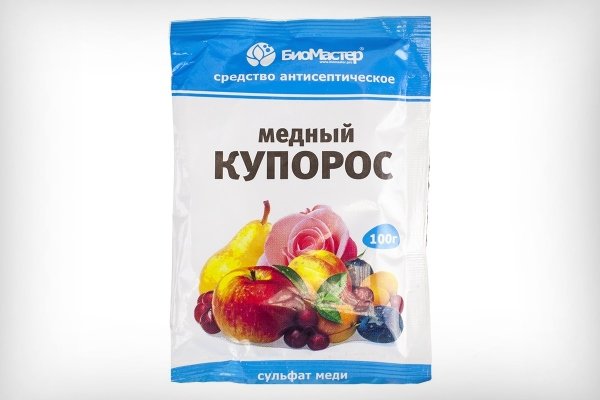

It is important to always keep under control the introduction of copper sulfate, since excess copper is harmful to the grape bushes.
inkstone
At an early stage, it is useful to treat the vine with copper sulfate. In addition to the fact that the soil will be additionally enriched with iron, the product perfectly removes pests and effectively fights diseases.
A weak solution can be prepared if the grapes are affected:
- gray rot;
- mildew;
- anthrocnosis;
- spotted necrosis.
Also, ferrous sulfate will delay the blooming of the bud, thereby protecting it from possible spring frosts.
Watch a video about the processing of grapes with iron vitriol after winter:
Bordeaux mixture
Bordeaux mixture is highly toxic. Also, do not abuse its concentration - use solutions of 2-3%, since a more saturated version of the liquid for processing can significantly reduce the rate of formation of the bush.
The first treatment is carried out on the unopened kidneys. To do this, it is necessary to thoroughly pour over the vine and the adjacent soil with a solution of 3% Bordeaux mixture.
The second treatment is carried out before the grapes begin to bloom. And they do it so that the Bordeaux mixture gets to where the brush will form. In this case, the concentration of the solution should be reduced to 1%.
With the same low concentration, the vine is treated when it has already bloomed.
During fruiting, grapes can also be processed, but it should be done with an eye to weather conditions. If the weather is too hot and dry, wait until 10 leaves grow. If the weather is excessively wet and rainy, then 5 leaves should form.
After the fruiting period, when the harvest has already been harvested, you can process the bush again, but this should only be done if there was an intense mildew damage to the vine during the growing season.
The success of this drug in grape agricultural technology lies in the fact that it stays on the plant for a long time, providing protection for 1 month from many diseases.
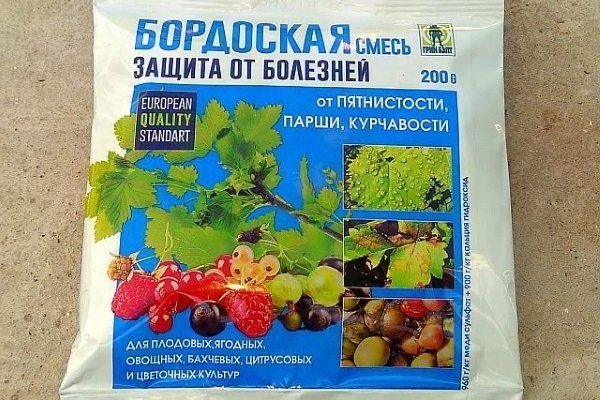

Urea
Urea is a nitrogenous substance.It should be introduced only when the plant reaches 2-3 years of age and in the spring. To do this, take approximately 20-30 g of the product per 1 liter of water, stir thoroughly and spray the plant so that both the vine and the soil under it are affected.
Urea is able to effectively fight insect pests, in addition to being a fertilizer for plant growth.
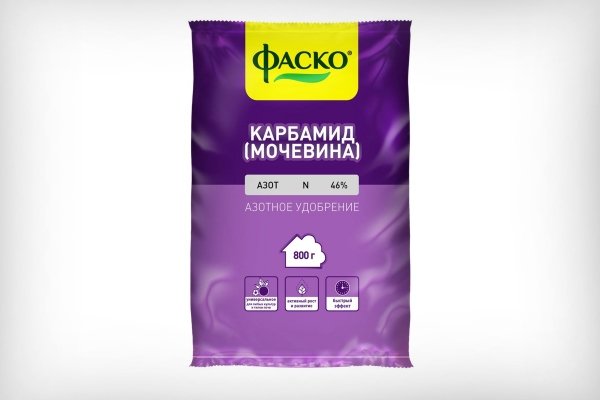

Colloidal sulfur
Colloidal sulfur treatment is very effective for a wide variety of diseases, fungal and mold lesions.
Colloidal sulfur treatment is not hazardous if the breeding instructions are strictly followed. In addition, it does not have a toxic effect on the plant itself, that is, it is a fairly environmentally friendly preparation.
It is worth processing only when sunny calm weather is established. There should be no precipitation. The drug should fall on both the outer and inner parts of the leaf.
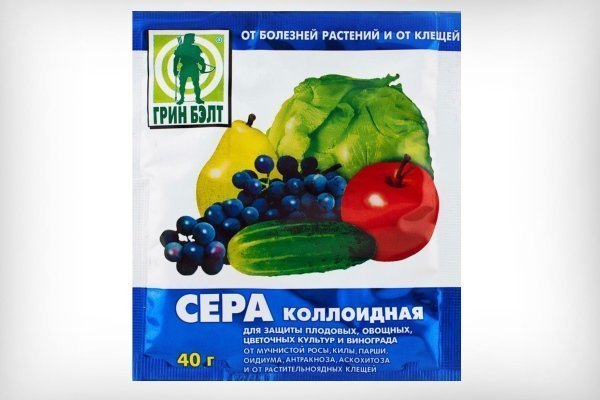

It should not be used during the onset of flowering and should not be mixed with other preparations.
Quadris
Quadris is a fungicide. In accordance with this, it is used not only for the destruction of fungi, but can also effectively cope with bacterial and viral diseases. Quadris is suitable for all grape varieties.
The drug within 2 days (this is how long its intense effect lasts) kills spores of fungi or other infectious agents. To apply the solution, you should strictly follow the instructions on the package.
Quadris effectively helps to destroy:
- mildew;
- gray rot;
- peronoporosis;
- oidium;
- black spot.
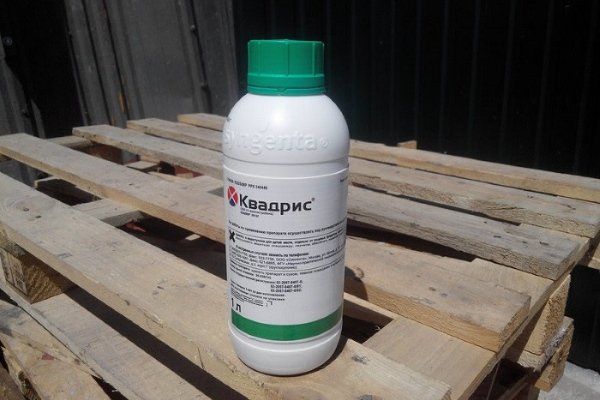

Ridomil
The use of Ridomil is justified when the vineyard is affected by:
- Alternaria;
- Mildew.
Ridomil should be used in the following concentration:
- for a large bush, 25 g of the drug per 10 liters of water;
- for a young bush - 10 g of the drug per 10 liters of water.
Positive characteristics of Ridomil:
- not phytotoxic;
- besides the fact that the bush itself is protected, the root system of the plant can also be protected;
- quickly penetrates into the plant.
The video below provides an overview of the drug "Ridomil", and also tells from which pest the bush is treated with this tool:
Problems that may arise after the winter period
First of all, with the onset of spring, you need to inspect the condition of the shoots and, in general, all the grapes.
- The vine can be affected by pests that hibernate in the bark. Such insects attack plantings in the fall and hibernate, their activity begins when it warms up outside and in the soil. Pests living on the bark of a plant and in the soil can feed on the vital sap of the plant, therefore, grapes affected by pests give a weak harvest and small fruits.
- Fungal infection. May appear if the summer has been rainy and cool. It appears as whitish spots on the shoots. Over time, the fungus attacks all green parts of the plant and the bark can rot. To avoid this, it is necessary to replace the topsoil if it is too wet, as well as to carry out antifungal treatments in time.
- Oidium. The affected areas are covered with an ashy and fetid bloom. Such a disease occurs if it is a hot summer. The bark of the shoots cracks and this leads to the development of other infections. If the oidium is not treated, then after wintering with the onset of spring, all bacteria reappear, and this will have a negative effect on the future harvest.
Folk remedies
If the vineyard is affected by aphids, then the plant can be washed with a soap solution with a ratio of 0.3: 10. To combat phyloxera, parsley should be planted next to the bushes of the vineyard. Fumigation of the bush with tobacco smoke will help from the leaf roll.
If caterpillars have grown on the vine, then you can get rid of them if you spray the grapes with a strong infusion of wormwood for 1 week, repeating the procedure daily.
The mite will disappear if you spray the plant with a decoction of onion husks.To prevent the development of mildew, dill bushes should be planted nearby or sprayed with milk diluted with water in a ratio of 1:10.
Sulfurous anhydride
How to treat a vineyard in early spring in order to effectively remove mold that has arisen? The most popular way to combat microorganisms is the treatment of grapes with sulfur dioxide (SO2). With such a mixture, molds can be blocked, since they simply do not continue to develop further. In the future, a small content of sulfurous acid reduces shedding and wilting of fruits. Fumigate grapes at a dosage of 0.2-0.25%. For this, about 3-5 grams of sulfur is burned per 1 m3 of the room.
This method is used mainly by more experienced gardeners and winemakers, as it requires skill and ability to properly process the plantings. Be sure to spray sulfur dioxide only when wearing a protective suit and gloves. This is a chemical element and should not be in contact with open areas of the body.
Features of processing grapes in spring in different regions
It is worth mentioning that more careful care will be needed for those plants that grow in not too prosperous regions to grow this crop.
Since humid weather is less common in the southern regions, the fungus develops less often. The more humid the climate in summer, the more carefully you need to monitor the plant.
In addition, many preparations are demanding on the temperature regime of spraying. The directions on the packaging must be followed closely.
You also need to consider that if the winters are cold, then you need to cover the vine with agrofibre. In the fall, it is important to remove all dead shoots and prevent fallen leaves and branches from accumulating under the bush.
Spraying rules
The health of plants in the garden depends on the correct management of seasonal activities. The first procedure must be carried out after removing the shelter in March and the garter to the supports. After hibernation, feeding the vine with urea can improve resistance to adverse conditions, protect it from insects and fungi.
The grapes are processed without the sun - in the morning or in the evening. Increased humidity due to dew deposited impairs spraying performance. If it rains after the event, you will have to repeat the steps. Windy weather complicates the procedure and becomes dangerous for humans.
Useful Tips
It is important to remember that the rule - the more, the better, does not work in the case of spraying, both chemical and biological. If you overdo it, you can harm the plant.
During spring processing, it is imperative to tie the branches before spraying. They should not lie on the ground. For this, you can use trellises or wire.
Severely affected areas of the plant should be removed and burned before processing. This will help prevent the spread of the disease.
In no case should you throw out the branches or leave them in an open space, as the disease can return or spread to a neighboring area, and from there return to its original place.
It is imperative to spray the grapes in the spring. This will help you avoid many problems and get the best harvest.
0
Diseases
Spring processing of grapes will help prevent the development of diseases caused by fungal spores and various microorganisms.
It is easy to identify the enemy by the appearance of various spots and bumps:
- downy mildew - yellow spots;
- powdery mildew (grape powder) - white spots;
- anthracnose - brown and brown spots;
- phomopsis - black spot;
- rot - gray, black and white;
- rubella - brown, reddish spots.
Prophylaxis
In order for the plantings to grow strong and healthy, and the harvest to be abundant and tasty, some aspects of care and cultivation must be observed. The very cultivation of grapes is a simple process, if you regularly inspect and spray the bushes with fungicides and preparations with the function of feeding. Some gardeners process grapes with urea. Such a remedy is effective against various diseases. If you cut the shoots, then you need to carry out this procedure very carefully, as bacteria can get into the cuts and the shoot will deteriorate.
In some cases, if liquid is released on the cut at the shoot, then a special garden pitch can be used. Such a pitch effectively seals the edges of the cut and does not let harmful microbes through to a healthy shoot. If you carry out all the necessary processing within the specified time frame, then in the spring you can completely restore and successfully prepare the planting of grapes for the further emergence and formation of fruits.

